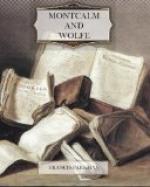Acadia—that it to say, the peninsula of Nova Scotia, with the addition, as the English claimed, of the present New Brunswick and some adjacent country—was conquered by General Nicholson in 1710, and formally transferred by France to the British Crown, three years later, by the treaty of Utrecht. By that treaty it was “expressly provided” that such of the French inhabitants as “are willing to remain there and to be subject to the Kingdom of Great Britain, are to enjoy the free exercise of their religion according to the usage of the Church of Rome, as far as the laws of Great Britain do allow the same”; but that any who choose may remove, with their effects, if they do so within a year. Very few availed themselves of this right; and after the end of the year those who remained were required to take an oath of allegiance to King George. There is no doubt that in a little time they would have complied, had they been let alone; but the French authorities of Canada and Cape Breton did their utmost to prevent them, and employed agents to keep them hostile to England. Of these the most efficient were the French priests, who, in spite of the treaty, persuaded their flocks that they were still subjects of King Louis. Hence rose endless perplexity to the English commanders at Annapolis, who more than suspected that the Indian attacks with which they were harassed were due mainly to French instigation.[72] It was not till seventeen years after the treaty that the Acadians could be brought to take the oath without qualifications which made it almost useless. The English authorities seem to have shown throughout an unusual patience and forbearance. At length, about 1730, nearly all the inhabitants signed by crosses, since few of them could write, an oath recognizing George II as sovereign of Acadia, and promising fidelity and obedience to him.[73] This restored comparative quiet till the war of 1745, when some of the Acadians remained neutral, while some took arms against the English, and many others aided the enemy with information and supplies.
[Footnote 72: See the numerous papers in Selections from the Public Documents of the Province of Nova Scotia (Halifax, 1869), pp. 1-165; a Government publication of great value.]
[Footnote 73: The oath was literatim as follows: “Je Promets et Jure Sincerement en Foi de Chretien que Je serai entierement Fidele, et Obeierai Vraiment Sa Majeste Le Roy George Second, qui (sic) Je reconnoi pour Le Souvrain Seigneur de l’Accadie ou Nouvelle Ecosse. Ainsi Dieu me Soit en Aide.”]
English power in Acadia, hitherto limited to a feeble garrison at Annapolis and a feebler one at Canseau, received at this time a great accession. The fortress of Louisbourg, taken by the English during the war, had been restored by the treaty; and the French at once prepared to make it a military and naval station more formidable than ever. Upon this the British Ministry resolved to establish another




